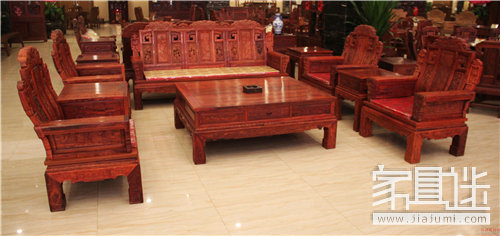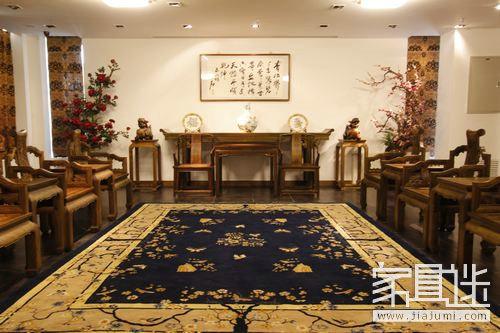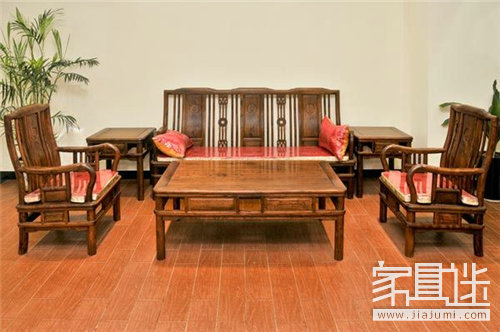Mahogany furniture refers to pieces crafted from rare hardwoods such as rosewood or other traditional redwoods. It is a general term used for high-quality, exotic wood furniture that has been popular since the Ming and Qing dynasties. In the 1980s, demand for mahogany furniture surged, prompting the need for industry regulation. The government established standards based on density and other characteristics, defining "redwood" as a category including species like two, five, eight, and thirty-three types. However, in the classical furniture industry, there are many premium hardwoods not included in the national "Redwood" standard. These so-called "leftover materials" still produce exquisite furniture, gaining recognition among connoisseurs.
**"Tough Guy" – Small-leaf Red Sandalwood**

**Leaflet Red Sandalwood Furniture**
Although small-leaf red sandalwood is not officially classified under the national "Redwood" standard, its popularity has surpassed many of the recognized redwoods. It is often compared to precious materials like huanghuali, rosewood, and Burmese rosewood. When first hearing the name "small-leaf red sandalwood," many might assume it belongs to the red sandalwood or Dalbergia genus. In reality, its scientific name is *Pterocarpus indicus*, and it is not considered a national standard redwood.
Small-leaf red sandalwood is a dark, expensive hardwood known for its extreme hardness, strength, and wear resistance, making it a true "tough guy" in the world of wood. Its heartwood displays a reddish-brown hue with staggered grain and fine, uniform structure. These qualities make it highly desirable. Due to its similarity in texture, color, and structure to red rosewood, some unscrupulous sellers have tried to pass it off as genuine red rosewood.
Despite not being part of the official standard, small-leaf red sandalwood has gained significant market recognition. Companies like Zhongshan Muyuan Redwood Furniture Co., Ltd. have positioned themselves around this material, emphasizing its quality and value. As more consumers become aware of its attributes, non-standard redwoods are beginning to carve out their own place in the market.
**Related Reading:** Lushi Black Rosewood, Big Leaf Rosewood – Is It Mahogany?
**Emperor's Wood – Golden Nanmu**

**Jin Sina Furniture**
"The golden silk comes from Sichuan, and the wood grain resembles gold threads. The beauty of Nanmu is unmatched, as if illuminated by sunlight or painted with scenery." This description appears in *The Museum of the Museum* (Minggu Taiteng), referring to *Nanmu*, specifically *Golden Nanmu*. This wood contains yellow-white sediments that reflect light, creating a golden-like pattern on its yellow-brown surface, resembling golden filaments.
The golden sheen of Golden Nanmu gives the furniture an air of nobility. Native to Sichuan, Yunnan, Hubei, and other regions, this wood was historically reserved for imperial use, including the emperor’s dragon throne. In ancient times, *Jinshen* symbolized power and honor, and commoners were forbidden from using it. Hence, it was also known as "the king’s wood."
While once exclusive to the elite, Golden Nanmu furniture is now more accessible. Jinnanmu beds and palace chairs are commonly found in the market today. Its stable structure and elegant grain make it appealing to modern consumers who can now experience the luxury once reserved for royalty.
**"Pattern Princess" – Brazilian Pear**

**Brazilian Rosewood Furniture**
Known as "Bahua" in Chinese, Brazilian pear is not related to rosewood despite its name. Botanically known as *Guibourtia tessmannii*, it is native to tropical Africa and is regarded as one of the most beautiful woods globally. Its long flowering cycle results in unique patterns formed by wind, rain, and soil, creating wavy, pearl-like, ghostly, or ball-shaped grain patterns. This makes it a true "pattern princess."
As a premium hardwood, Brazilian pear is gaining attention in the furniture industry. Beyond its high-quality properties, its striking wood grain adds aesthetic appeal, making it highly sought after by consumers. The saying goes, "Wood is rosewood, people are divided into three or six categories," highlighting that each wood has its own distinct charm. While the national "Redwood" standard includes thirty-three varieties, there are many non-standard woods like small-leaf red sandalwood and Golden Nanmu that deserve equal recognition. By leveraging their unique characteristics, we can address resource shortages and continue crafting traditional furniture.
**"Scentwood" – African Sandalwood**

**African Sandalwood Furniture**
When people hear the word "sandalwood," they often think of medicinal herbs or incense. However, African sandalwood is not the same. Though similar in name, the difference between the two is vast. African sandalwood, also known as sandalwood rosewood, is found in East, Southern, and South Africa. It has a strong density, beautiful patterns, and dark brown heartwood with black streaks, making it ideal for high-end furniture.
In addition to its superior physical properties, African sandalwood emits a distinctive fragrance, which is why it is sometimes called "sandalwood" in Jiangsu, China. This scent is very appealing to consumers, and furniture made from this wood can fill a bedroom with a refreshing, subtle aroma.
Currently, many traditional redwoods like Siamese rosewood are becoming scarce, prompting the industry to seek alternatives. Although African sandalwood is not part of the "five genera and eight categories" classification, its color, texture, and appearance surpass many standard redwood varieties. Many mahogany furniture manufacturers are now exploring its potential, recognizing its value in the evolving market.
Pvc Cosmetic Bag,Pvc Makeup Bag,Pvc Toiletry Bag,Clear Pvc Makeup Bag
Ningbo Fineweather International Trade Co., Ltd. , https://www.fwsbag.com